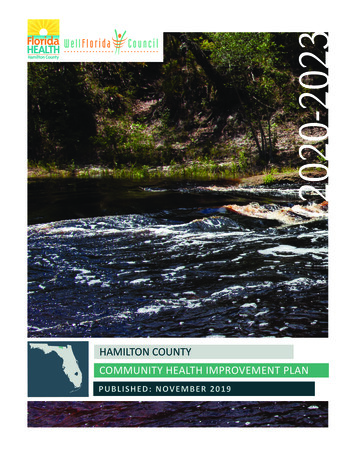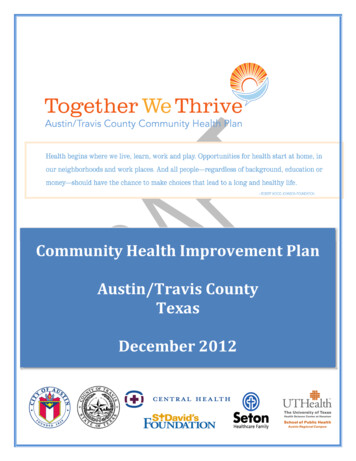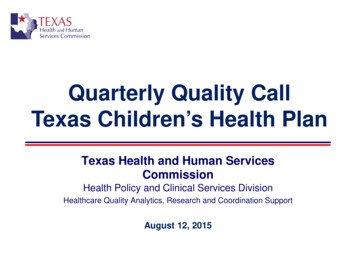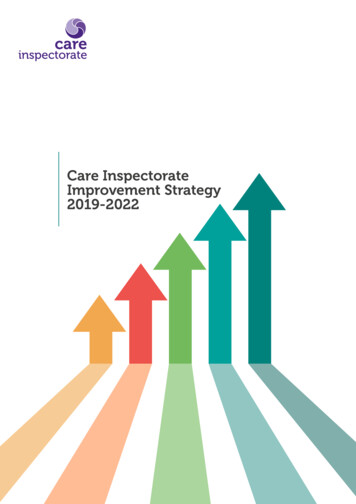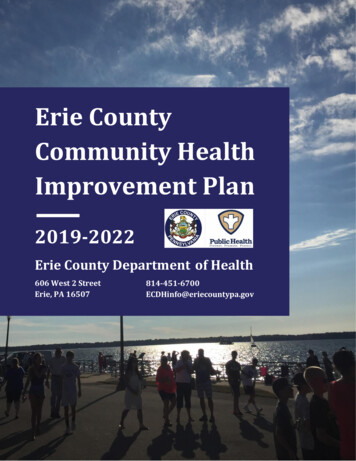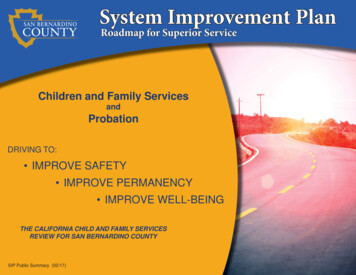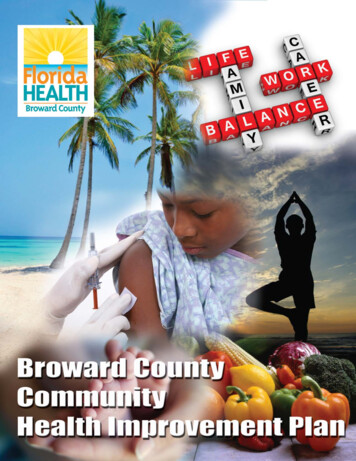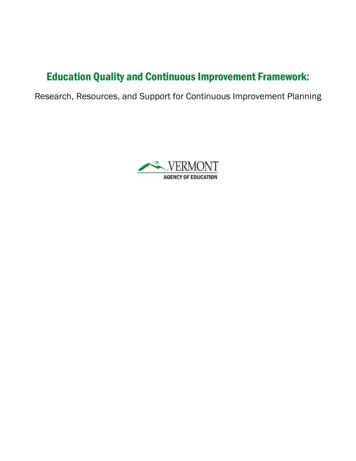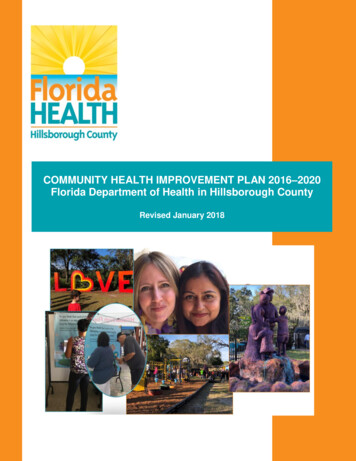
Transcription
COMMUNITY HEALTH IMPROVEMENT PLAN 2016–2020Florida Department of Health in Hillsborough CountyRevised January 2018
MissionTo protect, promote and improve the health of all people in Florida through integrated,state, county, and community efforts.VisionTo be the healthiest state in the nation.Values (ICARE) Innovation – We search for creative solutions and manage resources wisely. Collaboration – We use teamwork to achieve common goals and solve problems. Accountability – We perform with integrity and respect. Responsiveness – We achieve our mission by serving our customers andengaging our partners. Excellence – We promote quality outcomes through learning and continuousperformance improvement.PrinciplesHonesty, Fairness, Devotion, Courage, and ExcellenceThis report is available at the Florida Department of Health–Hillsborough County website at:http://hillsborough.floridahealth.gov/
TABLE OF CONTENTSINTRODUCTION . 2SUMMARY OF COMMUNITY HEALTH ASSESSMENT . 5CONFIRMING COMMUNITY PRIORITIES . 7CHIP REVISIONS . 8ACTION PLANS . 9PRIORITY AREA 1: ACCESS TO CARE . 9PRIORITY AREA 2: BEHAVIORAL HEALTH . 11PRIORITY AREA 3: OBESITY . 14PRIORITY AREA 4.1: HEALTHY MOMS AND BABIES . 16PRIORITY AREA 4.2: HEALTHY MOMS AND BABIES . 17PRIORITY AREA 5: HILLSBOROUGH HEALTH LITERACY INITIATIVE . 19CHIP MONITORING PLAN . 20CHIP ALIGNMENT WITH INTERNAL PLANS AND INITIATIVES . 24CHIP ALIGNMENT WITH STATE AND NATIONAL GOALS . 25CHIP ALIGNMENT WITH PARTNERS’ PLANS AND INITIATIVES . 28APPENDIX . 29Florida Department of Health in Hillsborough CountyCommunity Health Improvement Plan 2016–2020Revised January 20181
INTRODUCTIONINTRODUCTIONThe Florida Department of Health in Hillsborough County (DOH–Hillsborough) completesa Community Health Assessment (CHA) and Community Health Improvement Plan(CHIP) every 3 – 5 years. The current CHA, Florida Department of Health – HillsboroughCommunity Health Assessment 2015/2016, was developed by DOH–Hillsborough staffwith the assistance of Legacy Consulting Group. Completing the assessment involvedinput from many community members and partners. The CHA included assessing theCommunity Health Status, Community Themes and Strengths, Forces of Change, andthe Local Public Health System to determine the overall health of the community. TheCommunity Health Status Assessment was done using secondary data analysis fromsources including Florida CHARTS, the US Census Bureau, and the Robert WoodJohnson Foundation. The Community Themes and Strengths Assessment wascompleted using primary data gathered by administering a community survey, conductingfocus groups, and completing key-informant interviews. The survey questionnaireadministered to community residents, as well as the questions used to lead focus groupsand key-informant interviews, are included in the CHA. Results from the four assessmentswere used to determine priority areas for the county. The CHIP was created with actionplans for partners to work on over a three year period, to address the priority areasidentified in the CHA, and to improve the community’s health. The completed CHA reportwith the background, methods, assessment results, and list of assets and resources canbe found at https://hillsborough.floridahealth.gov.The CHA and CHIP were completed using the guidelines set out in the NationalAssociation of County and City Officials’ (NACCHO’s) Mobilizing for Action throughPlanning and Partnerships Model (MAPP).Healthy Hillsborough was formed in October 2015 as a collaboration between DOH–Hillsborough, Florida Hospital, Moffitt Cancer Center, St. Joseph’s Hospitals and SouthFlorida Baptist Hospital, Suncoast Community Health Centers, Tampa Family HealthCenters, Tampa General Hospital, and Shriners Hospitals for Children – Tampa. Thecollaborative was established to complete a comprehensive Community HealthAssessment (CHA)/Community Health Needs Assessment (CHNA) and to identifyopportunities for collaboration to collectively impact and improve the health ofHillsborough County.The Healthy Hillsborough collaborative, along with more than 140 community partnersand stakeholders met on April 1, 2016 to identify priority areas to focus on for the nextthree years. During this Strategizing for a Healthy Hillsborough meeting, attendeesbrainstormed and ranked current issues facing the County to identify priority areas. The2Florida Department of Health in Hillsborough CountyCommunity Health Improvement Plan 2016–2020Revised January 2018
INTRODUCTIONthree Priority Areas identified include: Access to Care, Behavioral Health, and Obesity.The four themes of Encourage Healthy Behaviors, Prioritize Racial and Ethnic HealthDisparities, Improve Health Collaboration, and Address the Social Determinant of Health,were interwoven throughout the three Priority Areas and will be systematically addressedwithin a three year plan as part of the individual CHIP action plans. Figure 1 belowdemonstrates the relationship between the identified priority areas and themes. A fourthpriority area, Healthy Moms and Babies, focused on infant mortality, and was added as aresult of the Florida Department of Health’s statewide Florida Healthy Babies (FHB)Initiative. FHB is a health equity focused initiative that aligns with DOH–Hillsborough’sgreater vision to achieve health equity in the county through addressing health disparitiesand the social determinants of health.Healthy Babies Initiative Priority Area of FocusEncourage Healthy BehaviorsHealthyMoms andBabiesImprove Health CollaborationFigure 1: CHIP Priority Areas of FocusFlorida Department of Health in Hillsborough CountyCommunity Health Improvement Plan 2016–2020Revised January 20183
INTRODUCTIONTable 1: DOH–Hillsborough CHIP Priority Areas and GoalsCHIP Priority AreasGoalsIncrease access to health insurance among eligibleindividuals in Hillsborough CountyAccess to CareUnderstand transportation–related issues in accessinghealth care in Hillsborough CountyBehavioral HealthProvide the most appropriate level of care for those in needof behavioral health services in Hillsborough CountyObesityIncrease participation in Evidence–Based Interventions forobesityEliminate or reduce infant mortality by increasingpregnancy interval to greater than 18 monthsHealthy Moms and BabiesHillsborough HealthLiteracy Initiative4Eliminate or reduce infant mortality by raising awarenesson infant mortality and morbidity as an important healthissueImpact health inequities by addressing low health literacyFlorida Department of Health in Hillsborough CountyCommunity Health Improvement Plan 2016–2020Revised January 2018
COMMUNITY HEALTH ASSESSMENTSUMMARY OF COMMUNITY HEALTH ASSESSMENTThe Mobilizing for Action through Planning and Partnerships Model (MAPP) model wasthe framework used for the CHA process.Community Health Status Assessment: This assessment was conducted usingsecondary data to determine the health status of Hillsborough County and compare itsperformance in relevant indicators to peer counties. In many indicator measures,Hillsborough County did not perform as well as peer counties; however, in many of thesesame measures, the County has shown improvement since the previous CHA. Notable isthe improvement in the rate of violent crime in the County. Disparities in health outcomesacross race/ethnicity can be seen in many measures including modifiable behaviors,infant mortality, and adult health.Community Themes and Strengths Assessment: Key informants mostly reported thatHillsborough County is a “great place to live” due to weather, cultural diversity, availabilityof health care providers and academic institutions. Survey participants mostly viewedthemselves and their community as being healthy; however, they noted that the cost ofhealth care and health insurance persist as barriers for those who were unable to accesshealth care. They also identified obesity, cancer, and aging problems as the mostimportant health problems facing the community. Survey respondents and focus groupparticipants answered uniquely in identifying the most important health issues currentlyfacing the community. Survey respondents did not perceive access to health care asimportantly as did the focus group participants, and they ranked obesity as the mostimportant health issue. A smaller percentage of these respondents identified obesity asthe most important health issue when compared to the percentage of focus groupparticipants who identified obesity as the most important health issue. However, focusgroup participants did not mention mental health issues as very important while surveyparticipants did. And neither group identified infant health as an important issue.Local Public Health System Assessment: This involved scoring the local public healthsystem in its performance of the Essential Public Health Services. Overall, the systemscored 69.4%, indicating that the agencies and organizations that make up the systemperform a significant number of Essential Public Health Service activities. Three areasscored optimum activity level, which is the highest level of activity; however, opportunitiesfor improvement exist in the overall local public health system.Forces of Change Assessment: This assessment was conducted in April 2016 todetermine the external changes that may affect the community, and the opportunities andpotential threats that are associated with these changes. Major forces of change identifiedby the Healthy Hillsborough Collaborative include: political change/policy consequences,the affordability and access to health care, social determinants of health, carecoordination and collaboration, shifts and changes in population, and the opportunity forMedicaid expansion.Florida Department of Health in Hillsborough CountyCommunity Health Improvement Plan 2016–2020Revised January 20185
COMMUNITY HEALTH ASSESSMENTThe results of the Community Health Status Assessment, Community Themes andStrengths Assessment, and the Local Public Health System Assessment were presentedat a community stakeholder meeting in April 2016. At this meeting, the Forces of ChangeAssessment was completed. From these four assessments, the top ten health issueswere identified with Access to Care, Behavioral Health and Obesity selected as the keypriorities. DOH–Hillsborough staff also included a fourth priority area to the CHIP, HealthyMoms and Babies. This was included to align with the Florida Healthy Babies initiative.The complete CHA report with the background, methods, assessments results, and thelist of assets and resources can be found at https://hillsborough.floridahealth.gov.6Florida Department of Health in Hillsborough CountyCommunity Health Improvement Plan 2016–2020Revised January 2018
CONFIRMING COMMUNITY PRIORITIESCONFIRMING COMMUNITY PRIORITIESDOH-Hillsborough conducted a CHIP outreach project, Confirming Community Priorities (CCP)between May and July, 2017. The goals of the project were to inform residents about CHIP priorityareas and solicit feedback on these and other health issues for DOH-Hillsborough. A brief visualsurvey was administered to over 700 community residents at 18 different locations throughout thecounty including the Ybor Saturday Market, Libraries & other community events (Figure 2). Over80% of respondents affirmed that Access to Health Care, Mental Health & Substance Abuse andObesity are important health issues in the county and that DOH-Hillsborough should be focusedon them. Fewer respondents affirmed that Infant Mortality is an important issue in the county.Figure 2: Residents Completing the Visual Survey at CCP EventFlorida Department of Health in Hillsborough CountyCommunity Health Improvement Plan 2016–2020Revised January 20187
REVISIONSCHIP REVISIONSThis version of the CHIP is entitled COMMUNITY HEALTH IMPROVEMENT PLAN 2016–2020,reflecting the currently used 5 year MAPP cycle.To address the lack of awareness of the importance of infant mortality in assessing ourcommunity’s health, DOH-Hillsborough made changes to the language it uses in officialcommunication. Infant Death will be used to refer to the death of an infant occurring between birthand 1 year.In November 2017, DOH-Hillsborough launched a Health Literacy Initiative with the goal ofcreating an action plan by June 2018 to address health literacy in the community. This action planhas been included in the CHIP as priority area five.Action plans were updated to reflect current members. New and past members are identified inthe Appendix. Action plan monitoring will highlight the overarching themes of Health Equity,Encourage Healthy Behaviors, and Improve Health Collaboration. The monitoring tool has beenupdated to reflect this.The tables demonstrating DOH-Hillsborough CHIP alignment with various plans and initiatives atthe local, state and national levels, have been updated. The Healthy Moms and Babies actionplans were removed, as one of these action plans is complete and the other has beendiscontinued. Tables also reflect a change in strategy of the Access to Care workgroup, anddemonstrate alignments with the Hillsborough Health Literacy Initiative.8Florida Department of Health in Hillsborough CountyCommunity Health Improvement Plan 2016–2020Revised January 2018
ACTION PLANSACTION PLANSThe results of MAPP assessments, community discussions and a review of assets, were used bypartners to create the action plans for the CHIP priority areas of focus. Healthy HillsboroughSteering Committee members serve as co–chairs and held meetings with relevant partners toidentify the goals, objectives and other components of the actions plans. This was also done forthe Healthy Moms and Babies action plans with input from DOH–Hillsborough staff and the FloridaHealthy Babies workgroup. The resulting action plans are presented below. Evidenced–based,practice–based, or promising practices were considered for each action plan as well as policy andsystem changes needed to accomplish action steps or objectives.Priority Area 1: Access to CareAction Plan Workgroup Co–Chairs: Jenna Davis and Sonia GoodwinAction Plan Workgroup Members: Keri Eisenbeis, Stefanie Alt and Debi Hines – Baycare; Liza CruzCepeda – Crisis Center of Tampa Bay; Allison Nguyen – DOH-Hillsborough; Melanie Hall – FamilyHealthcare Foundation; Artie Fryer – Hillsborough County; Jenna Davis – Moffitt Cancer Center; LauraResendez, Sherri Gay, and Sonia Goodwin – Suncoast Community Health Centers, Inc.; Tamika Powe,Kimberly Brown – Tampa General HospitalRelevant Indicators: % of individuals under 65 years old who are uninsured in Hillsborough County(200,532;17.8% in 2014 (U.S. Census Bureau Small Area Health Insurance Estimate))Goal: Increase access to health insurance among eligible individuals in Hillsborough CountySMART Objective: By September 30, 2019, reduce the percentage of uninsured individuals under 65 years old inHillsborough County by 2%.Strategy: Implement outreach and advocacy efforts for health insurance coverageAction StepsResponsibleTeam MembersAssess currentnavigationresourcesthroughoutHillsborough CountyJenna Davis,Sonia Goodwin,Melanie HallCreate anddistributeeducational videosabout insurance andenrollment criteriainformationAll team membersResourcesNeededOutput(Products)Staff time,technologyInventory ofnavigationresourcesIT assistanceSeries ofvideosFlorida Department of Health in Hillsborough CountyCommunity Health Improvement Plan 2016–2020Revised January 2018DateStartEndOctober 1,2016March 31,2017April 1,2017April 1,20189
ACTION PLANSResponsibleTeam MembersResourcesNeededOutput(Products)Liza CruzCepeda,Jenna Davis, ArtieFryer,Sherri GayKey partnersSAHIE databaseAction StepsUpdate 211 toreflect healthinsuranceinformation andpromote resourceacross thecommunityReview and trackthe U.S. CensusBureau’s Small AreaHealth InsuranceEstimates foruninsured dataJenna Davis,Sonia GoodwinDateStartEndUpdated 211resource(annually)October 1,2016September 30,2019Inventory ofSAHIEuninsureddata(annually)October 1,2017September 30,2019PROGRESS TO DATEThe Access to Care workgroup initially focused on increasing access to health insurance amongeligible individuals in Hillsborough County by implementing outreach and advocacy efforts forhealth insurance coverage. Due to the uncertainty surrounding the Affordable Care Act (ACA),the action plan activities were adjusted to focus broadly on information and guidance fornavigating the system, thereby improving access to needed services. The workgroup hasdeveloped training videos aimed at helping the public to navigate various aspects of accessincluding Preventative care, Where Can You Go Besides the ER? Can I get covered? and Whatto do after you have made your appointment? English & Spanish versions of videos have beencompleted. Creole versions of the videos are currently in production. Despite these changes theyear one target of reducing the number of uninsured persons under 65 years old in HillsboroughCounty from 200,532 (17.8%) to 169,320 (14.7%) has been met.The Access to Care workgroup acknowledged that issues related to transportation would factorinto this priority area. However, a complete framework within which to address this componentwas not feasible when the workgroup was initially formed. The Healthy Hillsborough SteeringCommittee met on July 31, 2017 to provide action plan updates. During this meeting, pursuing atransportation-focused Access to Care action plan was also discussed. However, due to variouslocal changes and some current transportation-related efforts that exist in Hillsborough County,the committee decided not pursue a new action plan focused on transportation at this time.10Florida Department of Health in Hillsborough CountyCommunity Health Improvement Plan 2016–2020Revised January 2018
ACTION PLANSPriority Area 2: Behavioral HealthAction Plan Workgroup Co–Chairs: Marsha Lewis-Brown and Clara ReynoldsAction Plan Workgroup Members: Jana Balicki – ACTS; Christina Bastone, Kathleen Chaykoski, DougLeonardo, Marsha Lewis-Brown and Gail Ryder – BayCare; Michelle Whittier – Brandon Regional Hospital/HCA;Carol Eloian, Marcia Monroe and Ruth Power – Central Florida Behavioral Health Network (CFBHN); ClaraReynolds – Crisis Center of Tampa Bay; Deanna Obregon and Mary Lynn Ulrey – DACCO; Chante Shifflett –Department of Corrections; Ayesha Johnson, PhD – DOH–Hillsborough; Joe Lallanilla, Melissa Powell andRoaya Tyson – Gracepoint; Barbara Macelli – Healthy Start; Shannon Rhodes – Hillsborough County; PhilipConti – Hillsborough County Health Care; Marie Marino – Hillsborough County Public Defender’s Office; Dep.Christopher Cullinan, Ana Maria Daniels and Dep. Stephanie Krager – Hillsborough County Sherriff’s Office;Sean Powell – Moffitt Cancer Center; Heather Rohan – NAMI Hillsborough; Tina Young – Project LINK;Kimberly Browne, Juliana Castillo and Seema Weinstein, PhD – Tampa General Hospital; Ashley Wynn –Tampa Hillsborough Homeless Initiative; Officer Dan McDonald – Tampa Police Department; Joe Bohn, PhD –USF College of Public Health; Glenn Currier, MD and Saundra Stock, MD – USF Morsani College of MedicineRelevant Indicators: Care Coordination Model drafted.Goal: Provide the most appropriate level of care for those in need of behavioral health services in Hillsborough County.SMART Objective: By December 31, 2017, develop a Care Coordination Model for High Utilizers in HillsboroughCounty.Strategy: Evaluate best practices and develop a care coordination model to address the needs of high-utilizers of behavioralhealth services in Hillsborough County.Action Steps1) Identify andevaluate relatedcare models &best practices2) Define highutilizers (ensurethat both medicaland behavioralhealth issues areincluded)3) Inventoryresources(including specificindividuals &organizationsworking on similarinitiativesResponsibleTeam MembersHealthyHillsboroughBH WorkgroupHealthyHillsboroughBH WorkgroupRuth Power, MarciaMonroe and/or LarryAllen (for publiclyfunded resources);Need leads to identifyother non–publicresourcesResourcesNeededKey PartnersKey tion of modeldescriptions, keyfeatures and criticalsuccess factors7/22/20169/30/2016Definition of highutilizers is drafted andapproved by the HealthyHillsborough BehavioralHealth work-group9/30/201612/31/2016Resource inventorydocument with keycontact information1/1/20173/30/2017Florida Department of Health in Hillsborough CountyCommunity Health Improvement Plan 2016–2020Revised January 201811
ACTION PLANSAction Steps4) Identify relevantdata5) Select carecoordinationmodel forHealthyHillsboroughResponsibleTeam MembersHealthyHillsboroughBH WorkgroupHealthyHillsboroughBH Workgroup6) Establish care andHealthycoordinationHillsboroughprocess andBH WorkgroupprotocolResourcesNeededKey PartnersKey PartnersOutput(Products)StartEndExecutive summary ofdata to define thecurrent state / need1/1/20173/30/2017Summary document todescribe the proposedcare model elementsand 201712/31/20171/1/2017Ongoing1/1/20187/31/2018 Summary document tomap the carecoordination processKey Partners Protocol created Protocol approved byparticipating providers7) Create multi–facility releaseMarcia MonroeKey PartnersMulti-facility releasedocument and process inplace for useAdditional Steps (if feasible)8) Identify potentialfunding sources to Healthypartner with toHillsboroughlaunch county–BH Workgroupwide coordinationmodel pilotKey Partners&FundingSource9) Evaluate the needfor awarenesscampaign /Develop acommunicationsplan to locatepeople in needKey PartnersHealthyHillsboroughBH WorkgroupCounty-wide pilot projectlaunchedAwareness campaign &communications plandevelopedPROGRESS TO DATEThe Behavioral Health workgroup is making progress toward its goal of providing the mostappropriate level of care for those in need of behavioral health services in Hillsborough County.Activities included evaluating best practices, and developing a care coordination model to addressthe needs of high-utilizers of behavioral health services in Hillsborough County. The proposedmodel, Hillsborough Coordinated Care Member Team, was presented to the Steering Committee12Florida Department of Health in Hillsborough CountyCommunity Health Improvement Plan 2016–2020Revised January 2018
ACTION PLANSon July 31, 2017. The model uses an integrated person-centered and care coordination plan thatincorporates physical health and behavioral health conditions into a single treatment plan.Persons eligible for this plan have had six or more interactions with law enforcement, theemergency room and/or crisis stabilization unit within a one year period.The workgroup is currently working on securing funding to implement this model as it wouldrequire at least two full time staff members. BayCare has committed 50,000 in matched funds.DOH-Hillsborough has also committed 25,000 towards this effort.Florida Department of Health in Hillsborough CountyCommunity Health Improvement Plan 2016–2020Revised January 201813
ACTION PLANSPriority Area 3: ObesityAction Plan Workgroup Co-Chairs: Tamika PoweAction Plan Workgroup Members: Stefanie Alt, Danielle Mauck & Elaine Oliver – BayCare Health System;Allison Nguyen – DOH-Hillsborough; Mary Willis & Amber Windsor-Hardy – Florida Hospital-West Region; CarlaSparks & Maria Russ – Hillsborough County Public Schools; Rocio “Rosy” Bailey and Zulema Uscanga – InSeason Pro; Tina Young – Project LINK, Inc.; Teresa Linder – Shriners Hospital for Children; Tamika Powe –Tampa General Hospital; Jamila Lepore – UF/IFAS Hillsborough Extension; Dawn Kita – YMCARelevant Indicators: Number of Participants in Evidence-Based Interventions for ObesityGoal: Increase Participation in Evidence-Based Interventions (EBI) for ObesitySMART Objective: By September 30, 2019, increase the number of people participating in evidence-based obesityintervention programs by 10%.Strategy: Conduct outreach and education for obesity management and prevention classes and programsAction StepsInventory existing EBIobesity programs fromCY 2015 to establish abaseline by recording1) The name of the EBIprogram;2) the ManagingOrganization of the EBIprogram;3) the total number ofparticipants in the firstclass for the entireyear.Inventory existing EBIobesity programs fromCY 2016 – September30, 2019 and record1) the name of the EBIprogram;2) the ManagingOrganization of the EBIprogram;3) the number ofparticipants in the firstclass; and4) the start date of theprogram.14ResponsibleTeamMembersObesity WorkGroupObesity WorkGroupResourcesNeededOutput(Products)The Department ofHealth will providea template for eachcommittee memberto use to record ourinformationA template for eachcommittee memberto record theirorganizationsrelevant informationDateStartEndInventory ofPrograms andClassesJune 1,2016October 1,2016Aspreadsheetwill provideongoingprogress andadditions on aquarterlybasisOctober 1,2016September30, 2019Florida Department of Health in Hillsborough CountyCommunity Health Improvement Plan 2016–2020Revised January 2018
ACTION PLANSAction StepsResponsibleTeam CommitteeMembersNumber ofpartners whoare partneringwith the workgroup to helpusaccomplishthe goal(annually)October 1,2016September30, 2019Obesity WorkGroupLocations foraccess points willbe needed as theybecome necessaryAccess pointsare lly)October 1,2016September30, 2019Increase healthcareprovider awareness ofwork group’s EBIObesity programs.Obesity WorkGroup1) DOH websiteaccess for programoriginator linkpostings, withprograms added asneeded2) A card directingpatients/participantsto the DOH websitefor access to EBobesity-focusedprograms in thecommunityCards arebeingdistributed tohealthcareproviders(yes/no;annually)October 1,2016September30, 2019Evaluate outcomesObesity WorkGroupWork groupmembers andevaluation toolCompletedevaluation(annually)October 1,2017September30, 2019Develop and enhancerelationships withpartners who can helpus increase the numberof participants in EBIobesity programs.Increase the number ofaccess points for EBIObesity programs asneeded.Obesity WorkGroupPROGRESS TO DATEThe Obesity workgroup continues to see an increase in participation in Evidence-BasedInterventions (EBIs) for obesity. The workgroup conducts outreach and education for obesitymanagement and prevention classess and programs. To date there have been 1,589 participantsin the various programs, representing approximately 75% of the year one target of 2,145.Florida Department of Health in Hillsborough CountyCommunity Health Improvement Plan 2016–2020Revised January 201815
ACTION PLANSPriority Area 4.1: Healthy Moms and BabiesAction Plan Workgroup Chair: Ivonne HernandezAction Plan Workgroup Members: Florida Healthy Babies WorkgroupRelevant Indicators: 3 Evidence-based strategies to increase access to Long Acting Reversible Contraceptives(LARC's); Host a community meeting to share findingsGoal: Eliminate or reduce infant mortality by increasing the pregnancy interval to greater than 18 monthsSMART Objective: By December 31, 2018, identify a minimum of three evidence-based strategies to increase accessto LARC's.Strategy: Research/Assessment – Identifying best models and best practices that increase access to LARCsAction StepsResponsibleTeam MembersResourcesNeededOutput(Products)StartEnd1) Research Coloradoand other bestpractices forincreasing accessto LARC’sIvonneHernandez –USF HealthUSF faculty,DOH staffA summaryidentifying anumber of bestpracticesOctober 31,2016March 31,20172) Identify a minimumof three strategiesthat increaseaccess to LARCs.Florida HealthyBaby PartnersFloridaHealthy BabyPartners3 best practicesare identifiedApril 30,2017May 31,20173) Host a communitymeeting to sharefindings withpartners who canadvocate for policychanges orincreasedresources and/orimplement bestpractice modelSophia Hector DOHDOH staff andFlorida HealthyBaby PartnersCommunitymeetingconvened.June 30,2017October 31,201716Florida Department of Health in Hillsborough CountyCommunity Health Improvement Plan 2016–2020Revised January 2018
ACTION PLANSPriority Area 4.2: Healthy Moms and BabiesAction Plan Work Group Co–Chairs: Sophia Hector, Tara SpillerAction Plan Work Group Team Members: Dr. Leslene Gordon, Sophia Hector, Allyson Sison, Noemi Padro, BonnieWatson, Dr. Ayesha Johnson, Susan Schmidt, Tara Spiller, Meghna DesaiRelevant Indicators: Implemented Social Marketing CampaignGoal: Eliminate or reduce infant mortality by raising awareness on infant mortality and morbidity as an important healthissue.SMART Objective: By December 31, 2018 create a county-wide social marketing campaign to raise awarenesson infant mortality and provide education on preventative strategies to reduce infant mortality.Strategy: Social Marketing and EducationAction Steps1) Research toidentify anyexisting socialmarketingcampaigns thatraises awarenesson infant mortalityand provideeducation onpreventativestrategies.2) Select an existingcampaign ordevelop acampaign3) Identify resourcesto implementsocial marketingcampaign4) Implement socialmarketingcampaign and/orsocial mediacampaignResponsibleTeam M
Florida Department of Health in Hillsborough County Community Health Improvement Plan 2016-2020 Revised January 2018 7 CONFIRMING COMMUNITY PRIORITIES CONFIRMING COMMUNITY PRIORITIES DOH-Hillsborough conducted a CHIP outreach project, Confirming Community Priorities (CCP) between May and July, 2017.
